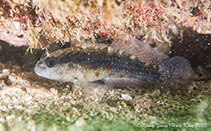| Family: |
Gobiidae (Gobies), subfamily: Gobiinae |
| Max. size: |
6.5 cm TL (male/unsexed) |
| Environment: |
reef-associated; marine; depth range 1 - 20 m |
| Distribution: |
Indo-Pacific: Persian Gulf (Ref.80050) and Red Sea to the Hawaiian, Line, and Tuamoto Islands, north to southern Japan, south to Lord Howe and Rapa. |
| Diagnosis: |
Dorsal spines (total): 7-7; Dorsal soft rays (total): 9-11; Anal spines: 1-1; Anal soft rays: 8-9. Body tan to black in color with light spots; midside with small elongate dark spots; short vertical bars or saddles above (Ref. 2798); characterized further by prolonged third dorsal spine , forms long filament in adult; longitudinal scale series 23-25; ctenoid scales; head scaled except snout and interorbital space; 3-9 close-set spines on edge of preopercle just above the corner; rounded caudal fin; depth of body 3.0-3.6 in SL (Ref. 90102). |
| Biology: |
Found on algal-coated reef rock and rubble of inner flats and turbid lagoons (Ref. 1602). Takes refuge in burrows or holes in the reef (Ref. 11441). Benthic (Ref. 58302). Feeds on small benthic invertebrates (Ref. 89972). Solitary or in small group (Ref 90102). |
| IUCN Red List Status: |
Least Concern (LC); Date assessed: 25 June 2018 Ref. (130435)
|
| Threat to humans: |
harmless |
Source and more info: www.fishbase.org. For personal, classroom, and other internal use only. Not for publication.

